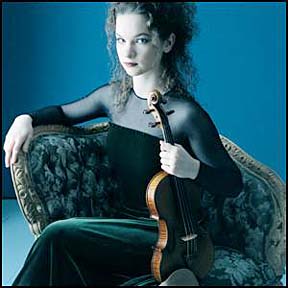


|
With her latest recording, 21-year-old violinist Hilary Hahn proves that she has moved beyond her teen-prodigy years and emerged as an important artist. The choice to pair these two concertos in one recording was made by Hahn, who felt equally passionate about the monumental masterpiece of the Brahms and the lesser-known Stravinsky. Violinist skillfully
marries 2 concertos"Brahms/Stravinsky Violin Concertos"
Hilary Hahn with the Academy of St. Martin-in-the-Fields, Sir Neville Marriner conductor (Sony Classical)Review by Mark Vogel
mvogel@starbulletin.comJohannes Brahms' Violin Concerto in D Major is a mammoth undertaking. The first movement contains a huge structure that demands strength, warmth and lyricism from both the soloist and the orchestra. Hahn and the Academy of St. Martin-in-the-Fields deftly handle the pacing of this potentially sprawling work. The violinist is particularly impressive in the first movement's cadenza where, free from the accompanying ensemble, she suspends the piece's forward momentum with tonal and dynamic shifts and impressive dialogue and echo effects.
Hahn makes her instrument sing in the beautiful adagio, demonstrating exquisitely long phrases that allow the music to float from the opening bars to the end.
The allegro movement dances with strong beats, momentous rhythm and crisp articulation. The extremely fast finale caps off a beautifully paced performance of this masterwork.
Igor Stravinsky's colorful and exuberant Violin Concerto in D Major makes a wonderful companion to the warmth and strength of the Brahms. Instead of lush chords from the strings, we hear a brighter sound with extensive use of the brass and woodwind instruments. (What would bassoonists ever play without Stravinsky?)
Stravinsky composed the piece in the spring and summer of 1931. The composer was not a violinist himself and felt insecure writing a major work for the instrument. So he initiated the help of Polish-American violinist Samuel Dushkin, who offered suggestions for expanding the range of possibilities of the violin. Stravinsky has the soloist begin each of the four movements with the same three-note, 2 1/2-octave chord. Technically, this chord boldly challenges the range of the instrument while structurally serving as the foundation for the whole work, linking all four movements.
Hahn makes the most of the piece's lightning-quick tonal shifts by highlighting sudden changes of dynamics and articulation. The forward momentum never ceases, especially in the delightful final movement, which sparkles with Stravinsky's colorful orchestrations. Here, the soloist shares a dialogue with various instruments in the ensemble, deftly moving from a conversation with flutes to pizzicato cellos, bassoons, trumpets and more.
With her latest release, Hilary Hahn has arrived.
Click for online
calendars and events.